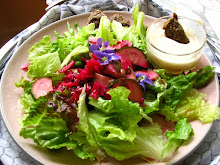
I learned to make raw Sauerkraut at a workshop taught by Jane and Loran Van Benthusen in Kansas City. I could not believe how simple recipe turned out to be because I feel in love with it on the first bite! I thought there must be some sort of trick. No trick. We make it all the time now and it comes out fantastic every time! I recommend their work-shops, recipes and classes! Check them out at: www.janevanbenthusen.com
Raw kraut is pro-biotic living food supplement that you make at home. If you have shopped for digestive enzymes you know, it can be really expensive to take a daily dose. This recipe will give you over a month's supply for the price of 2 heads of cabbage and 1/4 cup of high-quality salt. What are we at for a total there, around $2.50? It's also delicious! Even people you do not like sauerkraut (even people who do not like cabbage), seem to love this crunchy fresh raw kraut.
Kraut is a fermented food. What's the big deal? Fermented foods are critically important for transitioning to a cleansing diet that will boost your energy and allow your body to recover from years of eating meats, dairy and processed food. As i mentioned, you can also choose to supplement with high-quality digestive enzymes and pro-biotic powders. However, these are expensive, usually cultured from GMO dairy products and limited in the diversity of their pro-biotic structures. The most highly complex (and therefore the most beneficial) probiotics come from fermented foods. Home-made is always best!
Step-by-Step Kraut
Put on some rockin' music!
(Takes about 1/2 hour, or less for one jar, for two people. We prefer to put up several heads of cabbage at once. 'Cause it's messy. No biggy. Make the mess, quick clean-up, good-to-go again!)
Ingredients:
- High-quality Living Sea Salt
- Cabbage
That's it. If you like tradition German Sauerkraut flavor, add a few caraway seeds. If you want to mix it up and have different flavors, add celery seeds to some, fennel to others. Poppy seeds, cumin, hot pepper flakes and orange peel all work well too. You can also include other shredded veggies. Beets are gorgeous, turn the whole thing pink and add sweetness. Carrots, garlic, shallots, chives, tarragon leaves, mustard seeds and greens, kale and chard all work well too. I just love the plain.
Instructions:
Step one: Make a work-space on a solid surface. Plan for to make a mess. Wear an apron and don't bother to mop until later, put stuff away that you don't want to have to clean off later. It will get on the floor, it will stick to your shirt and you will splash it on anything you have setting out. Get out: a large mixing bowel, clean jar (or jars) with lid(s), something to pound it down with (I use the wand from the Vitamix or a couple of wooden pestles from an old Chensway Strainer. Some people have a large ladle soup ladle or a mallet wrapped in plastic that they like to use.

Step two: Figure out an efficient way to shred or chop the cabbage. I like my Saladmaster Cutter. Then, the floppy outer leaves over go into the Cusinart with the straight cut blade. Of course a chefs knife and a cutting board will do just as well.

Step 3: Get your groove on! Put about 3 to 4 inches of loose chopped cabbage in the jar, sprinkle with 1/2 tsp salt and pound-pound-pound until water appears. When your pounder starts to splash-splash-splash, add another 3 or 4 inches of cabbage and another 1/2 tsp of salt. ad any seeds or "extras" at each layer.
Step 4: Repeat until the jar is an inch from being full or the cabbage is gone. Ad any seeds or "extras" at each layer. One persona can be cutting while the other pounds. (Here's Jamie helping me out. If you know Jamie, here's a laugh: He's wearing a shirt that was a gift from Ana, it says, "Old Guys Rule," I reverse tie-dyed it for him.)

There will be quite a bit of water at the end. Note. We didn't ADD any water. It just comes out of the cabbage.
Step 5: When you have about an inch of space left in the jar above the "water level," fold an outer leaf from the cabbage, or you can use a large beat leaf or chard or grape leaf, to push in on top and keep the cabbage from oxidizing.
Step 6: You will now seal the jar and place it at warm room temperature for a week or more. WHATEVER YOU DO, DO NOT SKIP STEP 7.
Step 7: Make a post-it that says, "Burp Me" and stick it to the mirror or some place in your house where you will look at it every day. It is IMPORTANT to unscrew or pop the lid on your jars of kraut EVERY DAY. If you do not, they may burst. That's "Burst," as in, broken glass, wet cabbage and disappointment everywhere. Here is why use leave an inch. The inch at the top of the jar gives you a little squirm-room in case you would forget one time. We make it a practice to burp twice a day as a safety precaution. Also, whenever anyone in the family burps, it reminds us to check the jars.
Step 8: Tasting for "doneness." Don't bother to taste it until a full week has passed. It tastes pretty much like wet salty cabbage and you won't like it. If is still tastes like wet salty cabbage after a week, leave it a few more days, burping all the time and taste each day. You might see carbonation forming. This is good. Carbonation means its "cooking." You might see mold on top. This is not something to worry about. But, do remove it and replace the top leaf with a fresh one. Rarely, only in the heat of summer have I had this happen.
Step 9: Refrigerate: When the kraut is at it's desired "doneness," (for me, that is still crunchy, but discolored to mostly light gold with hints of green) burp one last time and transfer to the fridge.
Step 10: Eat it. Eat a good-sized fork full every day for probiotic balance, especially before or with a meal that contains cooked foods, carbs or protein. It seems to be a miracle cure for sweet-cravings. Great for heartburn, angina, arthritis, nausea and even headaches! Great medicine. You can't over-dose on fermented cabbage. Have as much as you like. Serve as a side dish. Mix with chopped veggies for a flavorful lunch.




 Instructions:
Instructions:




















